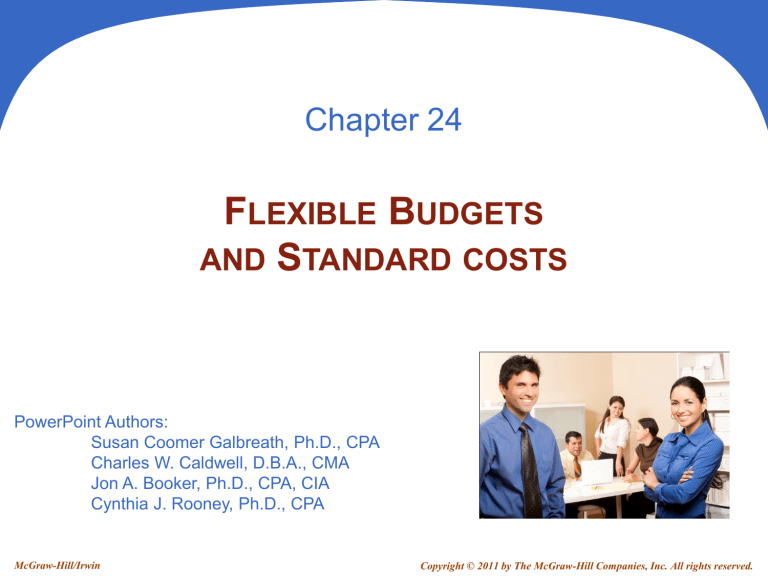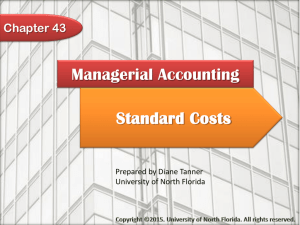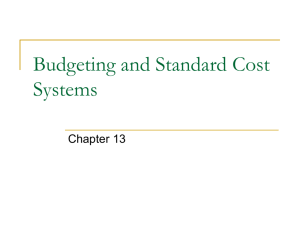
Chapter 24
FLEXIBLE BUDGETS
AND STANDARD COSTS
PowerPoint Authors:
Susan Coomer Galbreath, Ph.D., CPA
Charles W. Caldwell, D.B.A., CMA
Jon A. Booker, Ph.D., CPA, CIA
Cynthia J. Rooney, Ph.D., CPA
McGraw-Hill/Irwin
Copyright © 2011 by The McGraw-Hill Companies, Inc. All rights reserved.
24 - 2
BUDGETARY CONTROL AND REPORTING
Develop the budget
from planned objectives.
Revise
objectives
and prepare
a new
budget.
Management uses
budgets to monitor
and control
operations.
Take corrective and
strategic actions.
Compare
actual with
budget and
analyze any
differences.
24 - 3
PURPOSE OF FLEXIBLE BUDGETS
Show revenues and expenses
that should have occurred at the
actual level of activity.
May be prepared for any activity
level in the relevant range.
Reveal variances due to good cost
control or lack of cost control.
Improve performance evaluation.
24 - 4
P1
PREPARATION OF FLEXIBLE BUDGETS
To
a budget for different activity levels,
we must know how costs behave with changes in
activity levels.
Total variable costs change
in direct proportion to
changes in activity.
Total fixed costs remain
unchanged within the
relevant range.
Fixed
24 - 5
C1
STANDARD COSTS
Based on carefully
predetermined amounts.
Standard
costs are
Used for planning materials,
labor, and overhead requirements.
The expected level
of performance.
Benchmarks for
measuring performance.
24 - 6
C1
IDENTIFYING STANDARD COSTS
Practical standards should be set at levels that are currently
attainable with reasonable and efficient effort.
Engineer
Production
Manager
Human
Resources
Manager
Managerial
Accountant
Ideal standards, that are based on perfection, are
unattainable and discouraging to most employees.
24 - 7
C1
SETTING STANDARD COSTS
Price
Standards
Direct
Materials
Quantity
Standards
Rate
Standards
Direct
Labor
Time
Standards
Rate
Standards
Variable
Overhead
Activity
Standards
24 - 8
C1
SETTING STANDARD COSTS
A standard cost card might look like this:
24 - 9
C2
COST VARIANCE COMPUTATION
Standard Cost Variances
Price Variance
Quantity Variance
The difference between
the actual price and the
standard price.
The difference between
the actual quantity and
the standard quantity.
24 - 10
C2
COST VARIANCE COMPUTATION
Standard quantity is the quantity that should
have been used for the actual good output.
Actual Quantity
×
Actual Price
Actual Quantity
×
Standard Price
Price Variance
Standard Quantity
×
Standard Price
Quantity Variance
Standard price is the amount that should
have been paid for the resources acquired.
24 - 11
C2
COST VARIANCE COMPUTATION
Actual Quantity
×
Actual Price
Actual Quantity
×
Standard Price
Standard Quantity
×
Standard Price
Price Variance
Quantity Variance
AQ(AP - SP)
SP(AQ - SQ)
AQ = Actual Quantity
AP = Actual Price
SP = Standard Price
SQ = Standard Quantity
24 - 12
P2
LABOR COST VARIANCES
Actual Hours
×
Actual Rate
Actual Hours
×
Standard Rate
Rate Variance
Standard Hours
×
Standard Rate
Efficiency Variance
Materials
price variance
AH(AR
- SR) Materials quantity variance
SR(AH - SH)
Labor rate variance
Labor efficiency variance
Variable overhead
Variable overhead
AH
=
Actual
Hours
SR = Standard Rate
spending variance
efficiency variance
AR = Actual Rate
SH = Standard Hours
24 - 13
P2
LABOR COST VARIANCES
Using highly paid skilled workers to
perform unskilled tasks results in an
unfavorable rate variance.
High skill,
high rate
Low skill,
low rate
Production managers who make work assignments
are generally responsible for rate variances.
24 - 14
P2
LABOR COST VARIANCES
Poorly
trained
workers
Poor
quality
materials
Unfavorable
Efficiency
Variance
Poor
supervision
of workers
Poorly
maintained
equipment
24 - 15
OVERHEAD STANDARDS
AND VARIANCES
P3
Recall that overhead costs are assigned to
products and services using a predetermined
overhead rate (POHR):
Assigned Overhead = POHR × Standard Activity
POHR
=
Estimated total overhead costs
Estimated activity
24 - 16
P3
SETTING OVERHEAD STANDARDS
Contains a fixed
overhead rate which
declines as activity
level increases.
Contains a variable
unit rate which stays
constant at all levels
of activity.
Overhead
Rate
Function of activity level
chosen to determine rate.
Flexible budgets, showing budgeted amount of overhead for
various levels of activity, are used to analyze overhead costs.
24 - 17
CONTROLLABLE AND
VOLUME VARIANCES
P3
Overhead
cost
variance
(OCV)
=
Actual
overhead
incurred
(AOI)
–
Standard
overhead
applied
(SOA)
Total Overhead
Variance (OCV)
Controllable
Variance
Volume
Variance
24 - 18
END OF CHAPTER 24







